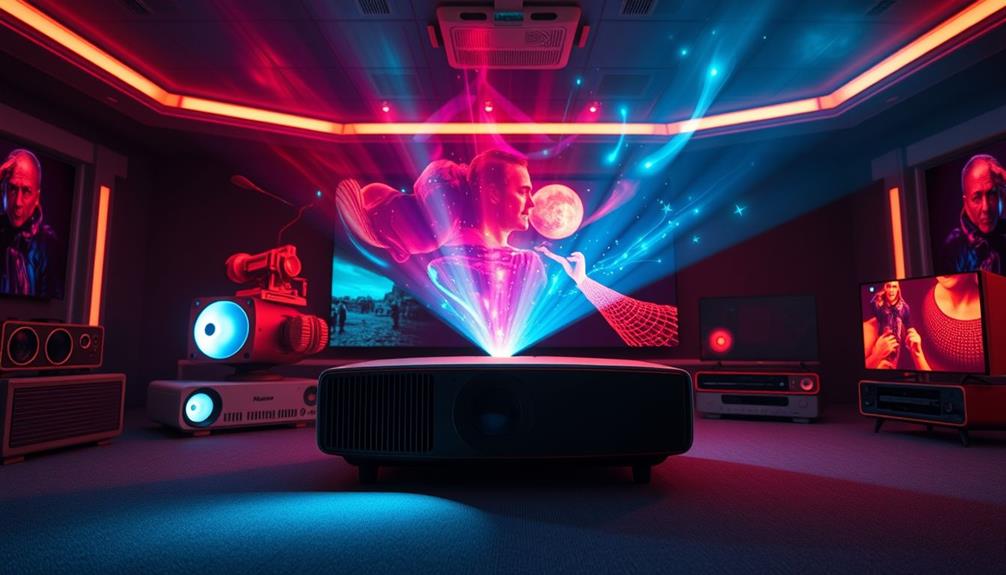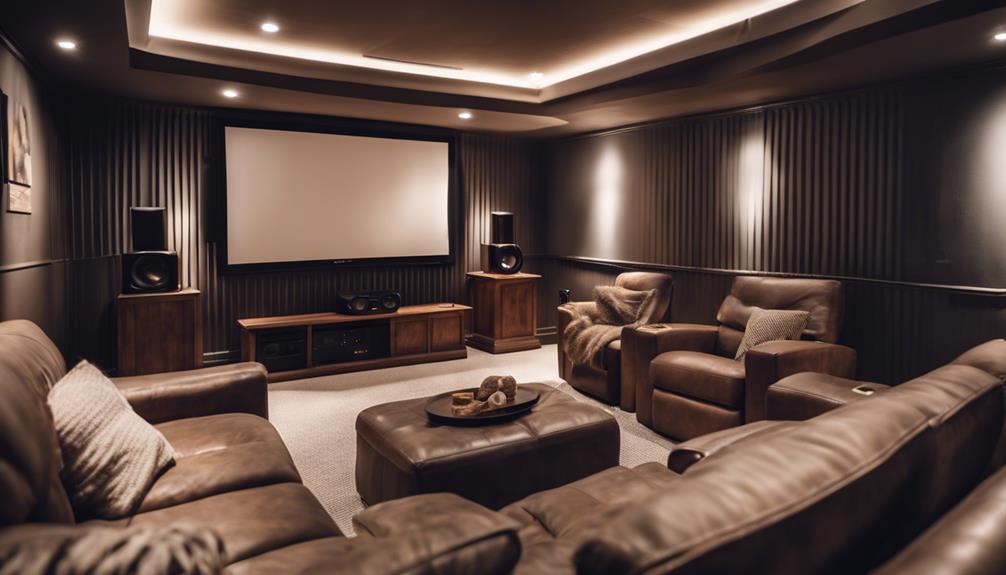3D projector technology uses advanced imaging to create stunning visual experiences across various fields. You'll find two main types: active and passive systems. Active systems use specialized glasses for high-motion content, while passive systems often employ lightweight polarized glasses. This technology's applications are vast, including entertainment, education, healthcare, and architecture. Innovations like projection mapping and VR integration are enhancing user engagement and interactivity. As industries embrace 3D visualization, you're likely to see more advancements that elevate how we perceive and interact with visual content. Keep exploring to uncover the exciting developments ahead!
Key Takeaways
- 3D projectors create depth perception using stereoscopic views and require specialized glasses for optimal viewing experiences.
- Active systems provide enhanced depth perception but are more complex, while passive systems offer simplicity and cost-effectiveness.
- 3D technology has diverse applications in entertainment, education, healthcare, architecture, and advertising, enhancing audience engagement.
- Innovations like advanced polarization techniques and projection mapping are transforming the capabilities and accessibility of 3D projection.
Overview of 3D Projection Technology

3D projection technology brings images to life by creating depth through stereoscopic views that engage your visual senses. This innovative approach uses stereoscopic projection, delivering two slightly different images—one for each eye—to simulate a three-dimensional effect.
To fully experience these immersive visual experiences, you'll need special glasses. Depending on the system, these glasses may be polarized or use active shutter technology. Polarized glasses filter the light coming from the projector, while active shutter glasses sync with the projector to alternately block each eye, ensuring you perceive the depth accurately.
As this technology continues to evolve, it enhances the quality of projections, making them more engaging and realistic. The rise in demand for 3D projection technology is evident, with applications expanding across entertainment, education, and healthcare sectors.
This trend points to a projected market growth at a compound annual growth rate (CAGR) of 22.5% from 2023 to 2030. With advancements in rendering software and the integration of virtual and augmented reality, you can expect even more immersive experiences that draw you into the content like never before.
Types of 3D Projectors

When exploring the types of 3D projectors, you'll encounter two main systems: active and passive.
Each has its own strengths and weaknesses, impacting your overall viewing experience.
Additionally, you'll want to take into account 3D ready projectors, which can enhance compatibility with various devices for better performance.
Active Vs. Passive Systems
Active and passive 3D projection systems each have unique advantages that cater to different viewing experiences and environments. When choosing between them, you'll want to evaluate your specific applications and preferences.
Active systems utilize specialized active shutter glasses, providing exceptional depth perception for high-motion content. However, they can reduce projector brightness by 40-60%, and you'll often incur higher costs due to the need for multiple glasses.
On the other hand, passive systems use lightweight polarized glasses that don't require synchronization devices, making them more cost-effective and user-friendly.
Here's a quick comparison to visualize their differences:
- Active Systems: Better for medical training and high-motion scenarios.
- Passive Systems: Ideal for museums and theme parks, enhancing viewer engagement.
- Glasses: Active requires heavier, synchronized glasses; passive uses lighter options.
- Brightness: Active systems may dim your projector, while passive systems maintain brightness.
Ultimately, your choice will depend on what fits your viewing experience best!
3D Ready Projectors
D Ready projectors provide the essential technology needed to display immersive 3D content, making them a popular choice for home theaters and professional presentations.
These projectors handle Frame Sequential data transmission, guaranteeing compatibility with various 3D media sources, such as Blu-rays. However, to fully experience their 3D capabilities, you'll need to invest in additional hardware like active glasses.
When choosing a 3D Ready projector, pay close attention to its specifications. Not all models come with integrated 3D functions, so it's vital to consult the product manual to confirm the projector's 3D capabilities.
Look for projectors that support Full HD resolutions, as they typically deliver superior image quality, enhancing your viewing experience.
It's also important to verify that your selected projector is compatible with the active glasses and media you'll be using. Misunderstandings about a projector's 3D capabilities can lead to disappointing viewing experiences.
Mechanisms Behind 3D Projection

3D projection relies on stereoscopic techniques that present two slightly different images to each eye, creating the illusion of depth. This technology is divided into passive systems and active systems, each employing unique mechanisms to deliver a fascinating 3D experience.
In passive systems, polarized light plays an important role. You'll need specialized glasses that filter the light, allowing your eyes to receive the correct images. This method enhances color fidelity and minimizes cross-talk.
In contrast, active systems utilize shutter glasses, which alternate between left and right images at high refresh rates. The result? A seamless 3D viewing experience that keeps your eyes engaged.
Here's what you can expect from these systems:
- Vibrant colors that pop off the screen
- Depth perception that immerses you in the action
- Crisp, clear images without visual strain
- Enhanced realism that draws you into the narrative
Understanding these mechanisms behind 3D projection technology helps you appreciate the intricate dance of light and perception that brings your favorite films and games to life.
Benefits of Active and Passive Systems

Understanding the mechanisms behind 3D projection reveals the distinct benefits that both active and passive systems offer to viewers and users alike.
Passive systems are known for their cost-effectiveness. They typically require less expensive equipment and don't need specialized glasses, making them accessible for more people. This simplicity greatly enhances the user experience, as you can easily set up and enjoy 3D content without additional gear.
On the other hand, active systems excel in specialized applications. They provide high-quality 3D effects essential for fields like medical training or simulations that involve considerable movement. However, these systems come with synchronization needs, requiring extra devices to sync projectors and glasses. This adds complexity and potential costs, which may deter some users.
Ultimately, your choice between active and passive systems depends on your specific requirements. If you're looking for an affordable, hassle-free experience, passive systems are likely the way to go. But if you need advanced 3D effects for specialized applications, active systems will deliver the quality you need, despite the additional setup involved.
Innovations in 3D Projection

Recent advancements in 3D projection technology are transforming how audiences experience visual content, making it more immersive and accessible than ever before. These innovations are paving the way for exciting possibilities in entertainment and design. Here's what you can expect:
- Advanced polarization techniques that enhance depth perception and visual quality in commercial cinemas.
- Lenticular displays allowing for 3D effects without the need for glasses, increasing accessibility for everyone.
- Projection mapping that turns irregular surfaces into dynamic canvases, perfect for events and advertising.
- Software improvements that elevate the rendering quality and realism of 3D images, making your viewing experience more engaging.
With these innovations in 3D projection, you'll find visual storytelling reaching new heights. Whether you're at a movie theater, an art installation, or an event, the enhanced visual quality and immersive nature of these technologies are set to captivate your imagination and redefine how you perceive content.
Industry Applications of 3D Technology

The versatility of 3D technology finds applications across various industries, markedly enhancing experiences in entertainment, education, healthcare, architecture, and advertising. In the entertainment industry, immersive 3D films and attractions captivate audiences, creating unforgettable memories. You'll notice how 3D projection pulls you into the action, making experiences more engaging.
In education, 3D technology transforms learning by providing interactive experiences that enhance understanding in subjects like biology and physics. You can visualize complex concepts and grasp them better.
Meanwhile, in healthcare, it plays a significant role in training simulations and patient education, allowing for realistic visualizations of intricate anatomical structures. This technology helps medical professionals improve their skills effectively.
Architecture utilizes 3D projection for visualizing building designs, enabling better planning and client presentations before construction begins.
Lastly, advertising employs 3D technology to create eye-catching displays that draw in consumers and boost brand engagement.
Here's a summary of these applications:
| Industry | Application |
|---|---|
| Entertainment | Immersive films and attractions |
| Education | Interactive learning experiences |
| Healthcare | Training simulations and education |
| Architecture | Design visualizations |
Reliability and Maintenance Considerations

When it comes to 3D projectors, ensuring continuous operation is key to a seamless experience.
You'll want to implement proactive maintenance strategies that help you catch potential issues early, preventing interruptions.
Ensuring Continuous Operation
To guarantee continuous operation of 3D projection systems, prioritizing reliability and regular maintenance is essential for minimizing downtime and enhancing audience engagement.
You should focus on several key areas to ascertain everything runs smoothly:
- Implement backup systems that kick in if primary equipment fails.
- Use remote monitoring software to catch potential issues before they turn into problems.
- Schedule maintenance checks to keep projectors and related gear in top shape.
- Ascertain projectors are well-ventilated and free from obstructions to prevent overheating.
Proactive Maintenance Strategies
Proactive maintenance strategies play an indispensable role in guaranteeing the reliability and longevity of 3D projection systems. By implementing these strategies, you can greatly reduce the likelihood of unexpected failures. Regular software updates are vital for optimizing projector performance and enhancing features.
Utilizing monitoring tools allows you to keep an eye on your equipment in real-time, quickly identifying potential issues before they escalate. This proactive approach helps maintain image quality and guarantees smooth operation during critical events.
Here's a quick overview of proactive maintenance strategies:
| Strategy | Benefits | Frequency |
|---|---|---|
| Routine Cleaning | Prevents dust accumulation, enhancing image quality | Weekly/Monthly |
| Software Updates | Improves projector performance and features | As needed/Quarterly |
| Monitoring Tools | Provides real-time performance data, enabling early issue detection | Continuous |
Training staff on handling and setup procedures is equally important. Proper training reduces the risk of user-induced damage and maximizes the potential of your 3D projection technology. By following these proactive maintenance strategies, you'll guarantee your systems operate at their best for years to come.
Downtime Minimization Techniques
Minimizing downtime in 3D projection systems is essential for guaranteeing a seamless experience, especially in entertainment and educational environments. To achieve this, you need to focus on several key techniques that enhance reliability and maintenance.
Here's what you should consider:
- Implement backup systems to guarantee continuous operation.
- Utilize redundant signals that can take over in case of primary system failure.
- Adopt remote monitoring technology for real-time performance tracking.
- Establish regular maintenance schedules to catch potential issues early.
User Experience and Engagement

User engagement in 3D experiences skyrockets when immersive presentations are utilized, especially in educational settings where information retention is essential. By harnessing the power of 3D technology, you can create a user experience that captivates and retains attention like never before.
| Element | Impact on Engagement | Example Application |
|---|---|---|
| Immersive Presentations | Enhances information retention | Interactive classroom lessons |
| Interactive Elements | Boosts viewer involvement | Real-time quizzes and feedback |
| Passive Systems | Increases accessibility | Museum exhibits without glasses |
The incorporation of interactive elements, like real-time feedback, fosters a deeper emotional connection to the content. Unlike passive systems, which can be limiting, immersive experiences draw you in, making learning and advertising more memorable. Imagine walking through a museum where the exhibits come alive, or experiencing a brand in a way that feels personal. Such environments are designed to create immersion, ensuring that your engagement isn't just momentary but lasting. In this rapidly evolving landscape, embracing these technologies can transform how you connect with information and experiences.
Future Trends in 3D Projection

The future of 3D projection is set to revolutionize how we experience content, blending immersive visuals with cutting-edge technologies like VR and AR. You can expect to see some exciting trends that will enhance your viewing experience:
- Integration of VR and AR: Creating hybrid environments that allow interaction with virtual elements.
- Higher Resolution: Advancements in technology will push for clearer, more detailed visuals.
- Enhanced Immersive Experiences: Expect a deeper engagement with content that feels more lifelike.
- Sustainability Initiatives: The industry is focusing on eco-friendly practices in the production and operation of 3D projection technologies.
As these advancements unfold, you'll find that 3D projection isn't just about watching—it's about experiencing.
The push for better resolution and immersive experiences signifies a shift toward a more engaging future. Additionally, sustainability will play a vital role, ensuring that the technology you enjoy is also environmentally considerate.
Get ready to embrace a new era of 3D projection that's interactive, vivid, and conscious of our planet!
Frequently Asked Questions
What Is 3D Technology in Projector?
3D technology in projectors creates depth by showing two images, one for each eye. You'll need specialized glasses, like active shutter or passive polarized, to fully experience the immersive visuals this technology offers.
What Are the Two Types of Technology Used in Projectors?
In projectors, you'll typically encounter two main technologies: LCD and DLP. LCD projectors deliver vibrant colors and sharp images, while DLP projectors offer high contrast and fast refresh rates, ideal for dynamic content.
Is 3D Worth It on a Projector?
Like a rollercoaster ride for your eyes, 3D on a projector can be thrilling, but it isn't always worth it. Consider the costs, potential eye strain, and brightness issues before diving into the 3D experience.
What Is the Difference Between 3D and 3D Ready Projector?
A 3D projector displays true 3D content directly, while a 3D ready projector needs compatible devices for 3D viewing. Always check specifications to verify you're getting the right projector for your needs.
Conclusion
As you explore the world of 3D projection, you'll see how it captivates imaginations while transforming industries.
The thrill of immersive experiences contrasts sharply with the challenges of maintaining complex systems. Each breakthrough brings excitement, yet the responsibility of reliability looms large.
Embracing these advancements, you're not just witnessing technology; you're part of a future where reality and innovation intertwine.
So, as you look ahead, remember: the journey of 3D projection is just beginning, and it's yours to shape.
Hello, I’m Art, and I’m excited to be a part of the 1Home Theatre Projector team. As a writer, I’m here to contribute my knowledge and insights to help you achieve the ultimate home cinema experience. I understand that making decisions in the world of home entertainment can be complex, and I’m here to simplify the process for you.
















